Setting Up Your Home Wok Kitchen: Stoves, Heat Sources, and Ventilation Guide
Setting Up Your Home Wok Kitchen: Stoves, Heat Sources, and Ventilation Guide
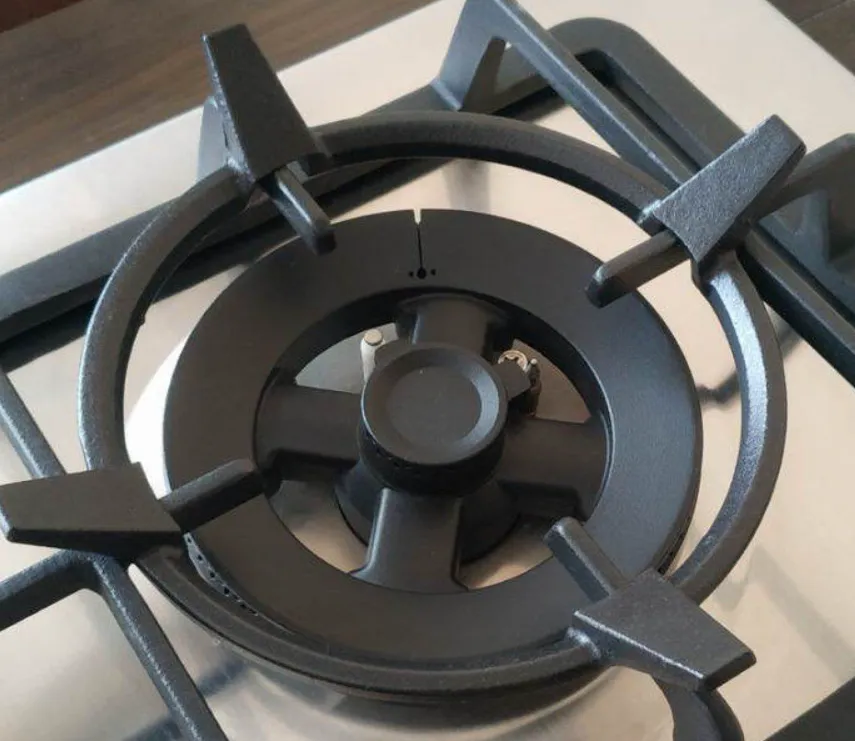 Gas stovetop with wok ring supporting round-bottom wok
Gas stovetop with wok ring supporting round-bottom wok
A wok's performance is inextricably linked to its environment. The heat source, stability, and ventilation of your cooking space will dramatically influence your results, determining whether you can achieve a sizzling stir-fry or are left with a steamy, lackluster meal. Understanding how to optimize your setup, whether indoors or out, is as crucial as selecting the right pan.
Reality Check: Most home kitchens are designed for Western cooking methods. Creating an effective wok cooking environment requires understanding the limitations and working within them - or finding creative solutions to overcome them.
Before setting up your kitchen, choose the right wok type for your stove and cooking style. Understanding why carbon steel performs best helps optimize your setup.
The Indoor Kitchen: Adapting to Your Stove
Most home kitchens are not designed with traditional wok cooking in mind, but with the right choices and techniques, you can achieve excellent results.
Gas Stoves: The Best-Case Scenario
This is the best-case scenario for indoor wok cooking. The open flame provides the kind of responsive heat a wok needs. For a traditional round-bottom wok, a wok ring is essential for stability, though it can lift the pan slightly away from the flame.
Professional Tip: Some cooks remove the burner's diffuser plate to create a more concentrated, jet-like flame that cradles the wok's bottom, though this should be done with caution and only if your range's design permits it.
A flat-bottom wok offers superior stability on a gas range without a ring, making it a more straightforward choice for many home cooks.
Gas Stove Optimization Tips:
- Wok ring placement: Position to cradle the wok securely without lifting it too high
- Burner selection: Use your largest, most powerful burner
- Flame adjustment: Start with high heat, adjust as needed during cooking
- Safety considerations: Ensure adequate clearance around the wok
Electric Stoves: The Challenge Zone
Cooking with a wok on an electric stove presents significant challenges. These stoves heat up and cool down slowly, robbing you of the precise temperature control needed for stir-frying.
Hard Truth: Electric coil and glass-top stoves are fundamentally incompatible with traditional wok cooking techniques. However, with the right approach, you can still achieve good results.
Electric Stove Adaptations:
- Flat-bottom mandatory: A flat-bottom wok is mandatory for these surfaces to ensure maximum contact with the heating element
- Preheating crucial: Allow extra time for the element to reach full temperature
- Heat management: Plan for slower temperature changes and adjust timing accordingly
- Surface protection: Be cautious with high heat, as rapid temperature changes can warp the wok
Warning: A round-bottom wok, even with a ring, will not heat effectively on electric surfaces and can reflect heat back, potentially damaging the burner.
Be cautious with high heat, as rapid temperature changes can warp the wok, and dragging the heavy pan can scratch glass cooktops.
Induction Cooktops: The Modern Solution
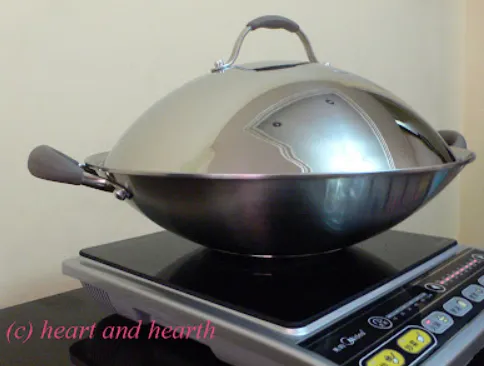 Flat-bottom wok positioned on modern induction cooking surface
Flat-bottom wok positioned on modern induction cooking surface
Induction offers fast, responsive heat, but it requires compatible, flat-bottomed cookware. A standard flat-bottom carbon steel wok will work, but specialized induction wok cooktops with a concave surface are available for enthusiasts seeking a more authentic experience.
Investment Consideration: Specialized induction wok cooktops can cost $200-500+ but provide excellent heat control and efficiency for dedicated wok cooking.
Induction Advantages:
- Instant heat control: Immediate response to temperature adjustments
- Energy efficiency: Direct heating of the wok bottom
- Safety features: Automatic shutoff and cool cooking surface
- Consistent temperature: Precise heat maintenance
The Heat Conundrum: Understanding BTUs
The single biggest difference between a home kitchen and a restaurant is heat output, measured in British Thermal Units (BTUs).
Home vs. Professional Power
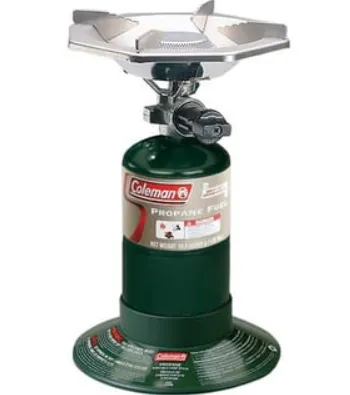 High-powered outdoor propane burner for wok cooking
High-powered outdoor propane burner for wok cooking
Home Kitchen Reality:
- Typical home gas burner: 7,000-15,000 BTU
- High-end home "power burner": Up to 27,000 BTU
- Most home electric: 5,000-8,000 BTU equivalent
Professional Kitchen Power:
- Commercial wok range: 100,000+ BTU
- Restaurant wok stations: Often 150,000+ BTU
- Industrial wok burners: Can exceed 200,000 BTU
The Math: A professional wok burner produces 6-20 times more heat than a home stove. This isn't just about cooking faster - it's about achieving fundamentally different results.
Why BTUs Matter: Recovery Time
This massive power difference affects the wok's "recovery time" - the time it takes to return to cooking temperature after adding ingredients.
The Recovery Time Effect:
-
High-BTU scenario: When you add ingredients to a hot wok, its temperature drops. A high-BTU burner reheats the pan almost instantly, maintaining a constant searing temperature.
-
Low-BTU scenario: A lower-BTU home burner struggles to recover, causing the food to release its moisture and steam rather than fry, resulting in a soggy texture.
Home Cooking Solution: The key to success on a home stove is to cook in very small batches to minimize this temperature drop. Think 1-2 servings maximum per batch.
The Outdoor Solution: Unleashing the Dragon
For those serious about replicating restaurant-quality results, the most effective solution is to take the cooking outside.
High-Pressure Propane Burners: The Game Changer
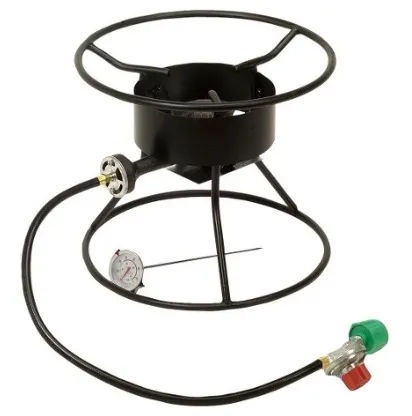 Complete outdoor wok cooking station with propane tank and burner
Complete outdoor wok cooking station with propane tank and burner
Often sold as "turkey fryers," these portable outdoor burners are the home cook's best friend for wok cooking. They are relatively inexpensive and can easily generate 50,000 to over 150,000 BTUs, providing the raw power needed for true, high-heat stir-frying.
Cost-Benefit Analysis: A quality outdoor propane burner costs $50-150 but can transform your wok cooking more than any other single equipment upgrade.
Outdoor Burner Setup Guidelines:
- Stable surface: Non-flammable surface at comfortable working height
- Wind protection: Screen or windbreak to maintain consistent flame
- Safety clearance: Adequate space around the burner for safe operation
- Fuel supply: Ensure adequate propane supply for extended cooking sessions
Grills: The Alternative Heat Source
A very hot gas or charcoal grill can also serve as a powerful heat source for a wok. Placing a round-bottom wok directly on the grates of a fully preheated grill can produce enough heat to get close to the wok hei effect.
Grill Wok Cooking Tips:
- Preheat thoroughly: 15-20 minutes at maximum temperature
- Direct placement: Round-bottom wok sits naturally in grill grates
- Wind considerations: Outdoor cooking requires wind management
- Safety protocols: Keep fire extinguisher nearby for oil fires
Ventilation: Clearing the Air
High-heat wok cooking generates a significant amount of smoke and aerosolized oil particles that can quickly fill a room, coat surfaces in a greasy film, and set off smoke detectors.
Indoor Ventilation Requirements
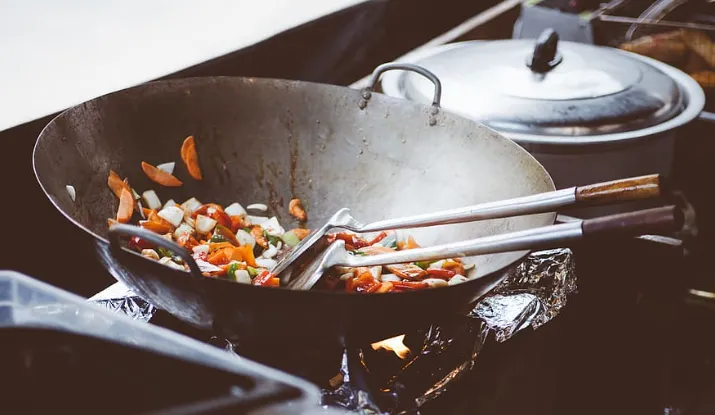 Kitchen range hood actively ventilating cooking smoke and steam
Kitchen range hood actively ventilating cooking smoke and steam
If cooking indoors, a powerful range hood is crucial. Look for a hood with a high CFM (cubic feet per minute) rating—600 CFM is often cited as a minimum, but more is better for serious wok cooking.
Ventilation Reality: Most standard residential hoods (200-400 CFM) are underpowered for authentic wok cooking. You may need to upgrade your ventilation system.
Range Hood Specifications:
- Minimum CFM: 600 CFM for occasional wok cooking
- Recommended CFM: 900+ CFM for regular wok cooking
- Capture area: Should be wider and deeper than your cooktop
- Noise level: Balance power with acceptable noise levels
- Duct size: Ensure ductwork can handle the airflow
Professional Installation Considerations:
- Electrical requirements: High-CFM hoods may require dedicated circuits
- Ductwork sizing: Inadequate ducts limit hood effectiveness
- Makeup air: Very powerful hoods may require makeup air systems
- Building codes: Check local requirements for ventilation systems
The Outdoor Advantage
Cooking outdoors on a propane burner or grill completely eliminates ventilation concerns, allowing you to cook at the highest temperatures without smoking out your home.
Outdoor Cooking Benefits:
- Unlimited ventilation: No smoke or grease concerns
- Higher heat capability: No indoor safety restrictions
- Authentic experience: Closer to traditional outdoor Chinese cooking
- Social cooking: Entertain guests while cooking
Safety Considerations for High-Heat Wok Cooking
Fire Safety
- Fire extinguisher: Keep appropriate extinguisher nearby
- Oil temperature monitoring: Use thermometer for deep-frying
- Escape routes: Ensure clear paths away from cooking area
- Emergency procedures: Plan for oil fires and gas leaks
Equipment Safety
- Stable surfaces: Ensure burners and woks are secure
- Protective equipment: Heat-resistant gloves and aprons
- Proper tools: Long-handled utensils for safety
- Regular maintenance: Check connections and equipment condition
Personal Safety
- Proper technique: Learn correct wok handling methods
- Adequate lighting: Ensure good visibility while cooking
- Comfortable workspace: Avoid awkward positions that could cause accidents
- Training: Practice techniques safely before attempting complex dishes
Creating the Optimal Wok Kitchen
Essential Equipment Checklist
- Primary heat source: Gas stove, outdoor burner, or high-power induction
- Ventilation system: Adequate hood or outdoor setup
- Wok selection: Appropriate bottom type for your heat source
- Support equipment: Wok ring, utensils, and safety gear
- Preparation area: Adequate space for ingredient prep
Budget-Conscious Approach
- Start simple: Master techniques on your existing stove
- Gradual upgrades: Improve ventilation, then consider outdoor options
- Multi-purpose equipment: Choose versatile tools
- Quality basics: Invest in good wok and basic utensils first
Premium Setup
- Outdoor wok station: High-BTU burner with professional setup
- Indoor backup: Powerful range with commercial-grade ventilation
- Complete toolkit: Full range of specialized wok equipment
- Multiple woks: Different sizes and styles for various applications
Proper setup enables advanced wok cooking techniques and wok hei achievement.
The key to successful home wok cooking lies in understanding and working with your equipment's limitations while maximizing its potential. Whether you're working with a basic gas stove or building an elaborate outdoor cooking station, the principles remain the same: maximize heat, ensure stability, and provide adequate ventilation. With the right setup and techniques, you can achieve restaurant-quality results in your own kitchen.
This article is part of our comprehensive wok cooking series. Next: "The Ultimate Wok Buying Guide: Shape, Size, and Handle Styles Explained"
Comments
Post a Comment